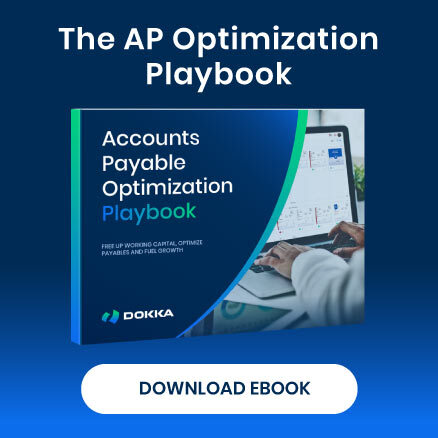Struggling with slow, manual AP workflows? DOKKA’s AP automation solution transforms how you process invoices, approve payments, and manage expenses—making your accounts payable faster, smarter, and more efficient from day one.
Did you know that 82% of businesses fail due to poor cash flow management—and inefficient accounts payable processes are often a major culprit?
Managing AP isn’t just about keeping the lights on – it’s about ensuring every dollar flows where it’s supposed to, on time.
Late payments? They erode supplier trust.
Manual invoice approvals? A bottleneck waiting to happen.
And don’t even get us started on the chaos of tracking expenses without a solid workflow.
So, what’s the secret to an AP process that works like clockwork?
Let’s explore.
What is an AP Workflow?
Accounts payable workflow is a series of steps and procedures used to manage payments to suppliers.
It typically involves the collection, review, approval, and recording of invoices received from vendors. The goal of AP workflow is to ensure that all vendor invoices are processed accurately and on time.
The process begins when an invoice is received and verified for accuracy, such as verifying that the correct goods or services have been provided at the right price.
If everything on the invoice is accurate and up-to-date, it can then be approved by appointed personnel for approval.
Following approval, payment can be made either directly from a bank account or with a check being sent out to the vendor.
nce payment is made, it is recorded in the financial ledger for future reference and reporting.
Accounts payable workflow can vary from company to company, but typically includes several core procedures:
- invoice verification
- approval
- payment
- record keeping
An effective AP workflow should ensure that all payments are accurate and prompt, as well as helping to reduce organizational costs associated with the manual processing of invoices.
What Are the Steps in The AP Workflow?

As mentioned, a typical AP workflow typically includes the following steps:
1) Invoice Data Capturing
AP staff will capture key data from an invoice, including the information of the vendor, items purchased, the cost for each item, the overall amount due, and the payment terms. In manual workflows, this initial step of data capturing is very time-consuming and prone to errors.
2) Invoice Verification
Once the data is entered into the ERP system, the invoice must be matched with the relevant purchase order (PO) and checked for accuracy. In some cases, delivery receipts are included as well, and the AP staff needs to conduct 3-way matching.
3) Managing Approvals
An approved manager or supervisor must validate each invoice before initiating payment. This step ensures accuracy and confirmation from the relevant department that purchased the goods or services.
4) Payment Processing
Depending on the payment methods agreed upon with the vendor, AP staff can either cut a check or initiate an electronic payment directly into the vendor’s account.
5) Recording Payment
All payments are recorded in accounting books for tracking purposes and proper financial reporting within a set time period (monthly or yearly).
7) Reporting
Reports are generated based on different criteria such as invoices paid within a certain time period or for specific vendors or items purchased, which can be used for budgeting purposes or strategic decision-making initiatives.
What Are The Challenges Of a Manual Accounts Payable Workflow?
The challenges of the AP workflow are numerous and can vary based on the size and complexity of the organization, but some common challenges include:
Data Entry Errors
Human errors and typos are a common challenge, especially in manual data entry processes. The problem is that errors in invoice data entry, such as wrong amounts, incorrect coding, or duplicate invoices, can cause discrepancies in the books and even wrong payments.
Poor Visibility
Having limited visibility into the AP process makes it difficult to identify issues early on. It also hinders collaboration between departments and eliminates opportunities for better financial management strategies that could potentially save money in the long run.
Timely Payment
Meeting payment due dates is essential for keeping suppliers happy and avoiding late fees or finance charges. Some AP workflows lack sufficient controls to ensure timely payment of vendor invoices.
The Risk of Over Payment
Without adequate controls and good visibility into AP activities, organizations can be susceptible to over payments that could have been avoided if proper checks and balances had been in place.
Lack of Automation
Manual processes can be time-consuming, error-prone, and inefficient. Without automation, it’s difficult to streamline the AP workflow for improved performance and accuracy.

Why You Should Automate Your AP Workflow?
Automating your AP workflow can offer many benefits that make managing your finances much simpler and more efficient. It eliminates the manual work associated with data entry and processing, making it easier to manage your payments.
AP automation also gives you greater visibility into your accounts payable system, allowing you to track expenses more accurately and quickly identify any potential problems. Furthermore, automation helps reduce the risk of errors from manual operations, like duplicate payments or wrong invoice data.
With an automated AP workflow in place, you can have faster payment processing times as well as improved supplier relationships. The cost savings from improved efficiency are an added benefit of automated AP workflow – making it one of the smartest investments you can make for your business.
How To Improve Your AP Workflow?
In conclusion, we bring you a few tips to make your AP workflow better and efficient:
Automate Accounts Payable Processes
Utilize automated AP solutions to streamline and simplify the accounts payable process.
Incorporating automated AP processes can improve workflow and save time, but also eliminate human errors that often occur in manual processes. Let the software take over mundane, repetitive tasks like data entry and invoice matching, allowing you to focus on more complex tasks.
Leverage Data Analytics
Use data analytics to gain insights into spending trends and vendor performance. Understanding this information can enable AP staff to identify areas for cost savings, improved supplier relationships, or better practices in terms of payment terms or discounts.
Improve Internal Communication
Ensure employees are communicating internally regarding invoices received, discrepancies noticed, payment schedules, etc., so that potential issues are caught early on and addressed accordingly. It will help prevent any slips in the process that could lead to delays in payments or incorrect payments being sent out.
Take Advantage of Early Payment Discounts
Nurturing good relationships with vendors can lead to some significant savings. Many suppliers offer discounts for early payments, so take advantage of early payment discounts when possible as this can help reduce overall costs associated with paying vendors on-time.
Monitor Vendor Performance
Closely monitor vendor performance by having team members review pending invoices and track payments regularly as it is essential for ensuring accuracy for all accounts payable processes. Also consider reaching out to vendors directly, for example quarterly, to discuss any potential discrepancies found during the audit process, such as duplicate invoices or incorrect pricing/amounts charged for items purchased from them.
Monitor Invoice Processing Times
Establish an efficient timeline for invoice processing that clearly outlines when each step should take place from invoice entry to payment approval. Monitoring this timeline ensures that vendors are paid on time and that any discrepancies are addressed in a timely manner.
Establish Approval Workflows
Here is where things can get complicated sometimes, but establishing good approval workflows is the safest way to ensure accuracy in invoices, eliminate unnecessary steps from the process, and reduce risk if there is a discrepancy between what was requested and what was delivered or billed for.




